3.1.6.13. SANISAND-MS Material
Code Developed by: Haoyuan Liu (Norwegian Geotechnical Institute (NGI), formerly TUDelft), José A. Abell (UANDES, Chile), Andrea Diambra (University of Bristol), and Federico Pisanò (TU Delft).
This command is used to construct a multi-dimensional SANISAND-MS (SAniSandMS) material, which is an extension of the Manzari-Dafalias (SAniSand) model with cyclic ratcheting control using the memory-surface (MS) concept. This allows capturing the ratcheting effects in sands that occur in high-cyclic loading in the presence of a static stress field or in the case of assymetric loading.
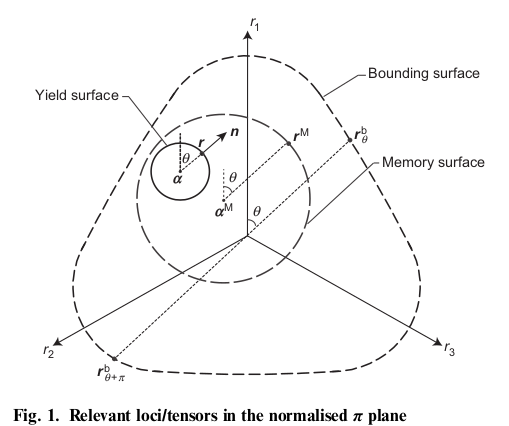
TCL command:
nDMaterial SAniSandMS $matTag $G0 $nu $e_init $Mc $c $lambda_c $e0 $ksi $P_atm $m $h0 $ch $nb $A0 $nd $zeta $mu0 $beta $Den $fabric_flag $flow_flag $intScheme $TanType $JacoType $TolF $TolR
Please report bugs as an issue on the main OpenSees repositoy and tag @jaabell
Where,
Argument |
Type |
Description |
|---|---|---|
$matTag |
integer |
unique tag identifying material |
$G0 |
float |
dimensionless shear modulus constant |
$nu |
float |
Poisson ratio |
$e_init |
float |
initial void ratio |
$Mc |
float |
critical state stress ratio |
$c |
float |
ratio of critical state stress ratio in extension and compression |
$lambda_c |
float |
critical state line constant |
$e0 |
float |
reference critical void ratio at p = 0 |
$ksi |
float |
critical state line constant |
$P_atm |
float |
atmospheric pressure |
$m |
float |
yield locus opening parameter (radius of yield surface in stress ratio space) |
$h0 |
float |
hardening parameter |
$ch |
float |
hardening parameter |
$nb |
float |
bounding surface void ratio dependence parameter $nb ≥ 0 |
$A0 |
float |
intrinsic dilatancy parameter |
$nd |
float |
dilatancy surface parameter $nd ≥ 0 |
$zeta |
float |
memory surface shrinkage parameter |
$mu0 |
float |
ratcheting parameter |
$beta |
float |
dilatancy memory parameter |
$Den |
float |
mass density of the material |
$fabric_flag |
integer |
(deprecated) |
$flow_flag |
integer |
(deprecated) |
$intScheme |
integer |
constitutive integration method (3: Runge-Kutta 4th order with error control (the only one currently implemented)) |
$TanType |
integer |
type of tangent stiffness to report (0: elastic stiffness | 1: continuum elastoplastic stiffness ) |
$JacoType |
integer |
placeholder (not used in explicit methods) |
$TolF |
float |
tolerance for yield surface intersection calculation (stress units) |
$TolE |
float |
(adimensional) relative error for explicit integrator |
The current implementation on SANISAND-MS uses fourth-order Runge-Kutta with error control for constitutive integration. The strain coming from a finite-element containing SANISAND-MS is applied incrementally by subdividing automatically to keep the constitutive integration error below the parameter $TolE. The integration error \(e\) is defined as:
And \(\sigma^p\) is the stress prediction using a \(p\)-th order integration formula, and likewise for the backstress \(\alpha^p\). Thus, in the code a 5-th order formula to approximate and bound the integration error, while integration advances using the fourth-order equation (RK45).
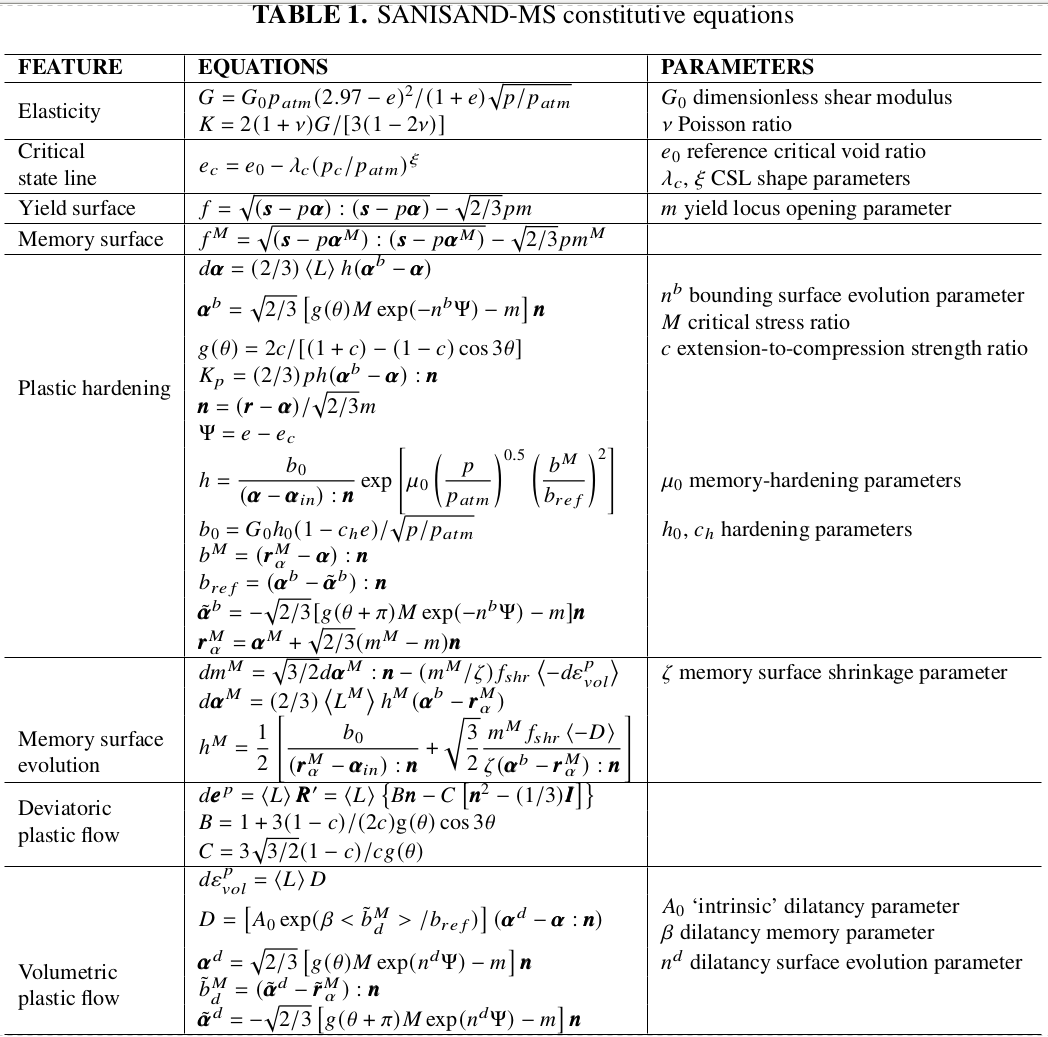
The above equations differ from those in the main reference by Liu et al. (2019) in that the use of the yield back-stress ratio \(\alpha\) is resumed here, as in Dafalias and Manzari (2004), to avoid certain numerical inconveniences.
Citation information
If you use SANISAND-MS in your published research work, please cite the main reference ([SANISAND-MS]) and also inform jaabell (at miuandes dot cl), to update the list of published articles and works that use the code.
Naming convention
In text documents we use the spelling SANISAND-MS, but the OpenSees implementation uses SAniSandMS to accomodate coding conventions in OpenSees.
Available formulations
The material formulations for the SAniSandMS object are “ThreeDimensional” and “PlaneStrain”
Recorder queries
Valid Element recorder queries are:
stressreturns stress tensor``strain``returns strain tensor
alphafor \(\mathbf{\alpha}\), the back-stress ratio tensor for the yield surfacealphaMfor \(\mathbf{\alpha^M}\), the back-stress ratio tensor for the memory surfacealpha_infor \(\mathbf{\alpha_{in}}\)MMsize of memory surfaceestrainelastic strain tensor
recorder Element -eleRange 1 $numElem -time -file stress.out stress
#. Elastic or Elastoplastic response could be enforced by
Elastic: updateMaterialStage -material $matTag -stage 0
Elastoplastic: updateMaterialStage -material $matTag -stage 1
Example
This example, provides an asymetric drained triaxial test of the constitutive model to show the effect of ratcheting. First the sample is compressed isotropically to 200KPa, then a cyclic deviator stress is applied.
set test_type "drained_triaxial_cyc" ;# Used in recorders.tcl
wipe
# Create a 3D model with 4 Degrees of Freedom
model BasicBuilder -ndm 3 -ndf 3
# Confinement Stress
set pConf -200.0
# Increment of q added at constant p0 (will be the average during cyclic loading)
set delta_qav -75.0;
# Amplitude of cyclic deviatoric stress
set delta_qcyc -60.0;
set G0 110. ; # [Adimensional]
set nu 0.05 ; # [Adimensional]
set e_init 0.72 ; # [Adimensional]
set Mc 1.27 ; # [Adimensional]
set c 0.712 ; # [Adimensional]
set lambda_c 0.049 ; # [Adimensional]
set e0 0.845 ; # [Adimensional]
set ksi 0.27 ; # [Adimensional]
set P_atm 101.3 ; # [kPa]
set m 0.01 ; # [Adimensional]
set h0 5.95 ; # [Adimensional]
set ch 1.01 ; # [Adimensional]
set nb 2.0 ; # [Adimensional]
set A0 1.06 ; # [Adimensional]
set nd 1.17 ; # [Adimensional]
set z_max 4 ; # For SAniSand [Adimensional]
set cz 0 ; # For SAniSand [Adimensional]
set mu0 260. ; # For SAniSand [Adimensional]
set zeta 0.0005; # For SAniSand [Adimensional]
set beta 1 ; # For SAniSand [Adimensional]
set w1 0.5 ;
set w2 2 ;
set Den 1.584 ; # [Mg/m^3]
set intScheme 3 ; # Corresponds to Modified-Euler integration scheme
set TanType 1 ; # 0: elastic stiffness, 1: continuum elastoplastic stiffness
set JacoType 1 ; # Not used in explicit methods
set TolF 1.0e-6; # Tolerances, not used in explicit
set TolR 1.0e-6; # Tolerances, not used in explicit
#Reference atmospheric pressure
set P_ref $P_atm
# Create material
nDMaterial SAniSandMS 1 $G0 $nu $e_init $Mc $c $lambda_c $e0 $ksi $P_atm $m $h0 $ch $nb $A0 $nd $zeta $mu0 $beta $Den $intScheme $TanType $JacoType $TolF $TolR
set type "RK"
# Create nodes
node 1 1.0 0.0 0.0
node 2 1.0 1.0 0.0
node 3 0.0 1.0 0.0
node 4 0.0 0.0 0.0
node 5 1.0 0.0 1.0
node 6 1.0 1.0 1.0
node 7 0.0 1.0 1.0
node 8 0.0 0.0 1.0
# Create Fixities
fix 1 0 1 1
fix 2 0 0 1
fix 3 1 0 1
fix 4 1 1 1
fix 5 0 1 0
fix 6 0 0 0
fix 7 1 0 0
fix 8 1 1 0
# Create element
# SSPbrickUP tag i j k l m n p q matTag fBulk fDen k1 k2 k3 void alpha <b1 b2 b3>
element SSPbrick 1 1 2 3 4 5 6 7 8 1
recorder Element -file ${type}_${test_type}_stress.out -ele 1 -time stress
recorder Element -file ${type}_${test_type}_strain.out -ele 1 -time strain
# Create analysis
constraints Transformation
test NormDispIncr 1.0e-4 20 0
algorithm Newton
numberer RCM
system BandGeneral
integrator LoadControl 0.0001
analysis Static
# Apply confinement pressure
set pNode [expr $pConf / 4.0]
pattern Plain 1 {Series -time {0 1 100} -values {0 1 1} -factor 1} {
load 1 $pNode 0.0 0.0
load 2 $pNode $pNode 0.0
load 3 0.0 $pNode 0.0
load 4 0.0 0.0 0.0
load 5 $pNode 0.0 $pNode
load 6 $pNode $pNode $pNode
load 7 0.0 $pNode $pNode
load 8 0.0 0.0 $pNode
}
analyze 10000
loadConst
puts "Starting monotonic analysis"
# Apply confinement pressure
set delta_sigma_a [expr $delta_qav*2./3.]
set delta_sigma_r [expr -$delta_sigma_a/2]
set pNode2 [expr $delta_sigma_r / 4.0 ]
set pNode1 [expr $delta_sigma_a / 4.0]
pattern Plain 3 {Series -time {1 2 100} -values {0 1 1} -factor 1} {
load 1 $pNode2 0.0 0.0
load 2 $pNode2 $pNode2 0.0
load 3 0.0 $pNode2 0.0
load 4 0.0 0.0 0.0
load 5 $pNode2 0.0 $pNode1
load 6 $pNode2 $pNode2 $pNode1
load 7 0.0 $pNode2 $pNode1
load 8 0.0 0.0 $pNode1
}
integrator LoadControl 0.0001
analyze 10000
loadConst
puts "Starting cyclic analysis"
set Ncyc 1000
set NcycActuallyDo 1000
set dT [expr 0.001]
set tmax [expr $NcycActuallyDo]
set numStep [expr int(2.0*$tmax / $dT)]
set qlist [list 0]
set timelist [list 2]
for {set i 1} {$i <= $Ncyc} {incr i} {
lappend qlist [expr $delta_qcyc/4.0] [expr -$delta_qcyc/4.0]
lappend timelist [expr 2*$i + 1] [expr 2*$i + 2]
}
set tsq "{Series -time {$timelist} -values {$qlist} }" ;#-factor 1}"
puts $tsq
# return
eval "pattern Plain 4 $tsq { load 5 0 0 1.0; }"
eval "pattern Plain 5 $tsq { load 6 0 0 1.0; }"
eval "pattern Plain 6 $tsq { load 7 0 0 1.0; }"
eval "pattern Plain 7 $tsq { load 8 0 0 1.0; }"
# Analyze and use substepping if needed
set remStep $numStep
set success 0
integrator LoadControl $dT
proc subStepAnalyze {dT subStep} {
if {$subStep > 10} {
return -10
}
for {set i 1} {$i < 3} {incr i} {
puts "Try dT = $dT"
# set success [analyze 1 $dT]
integrator LoadControl $dT
set success [analyze 1]
if {$success != 0} {
set success [subStepAnalyze [expr $dT/2.0] [expr $subStep+1]]
if {$success == -10} {
puts "Did not converge."
return success
}
} else {
if {$i==1} {
puts "Substep $subStep : Left side converged with dT = $dT"
} else {
puts "Substep $subStep : Right side converged with dT = $dT"
}
}
}
return success
}
puts "Finished static Start analysis"
set startT [clock seconds]
set startTime [getTime]
while {$success != -10} {
set subStep 0
integrator LoadControl $dT
set success [analyze $remStep $dT]
if {$success == 0} {
puts "Analysis Finished"
break
} else {
set curTime [getTime]
puts "Analysis failed at $curTime . Try substepping."
set success [subStepAnalyze [expr $dT/2.0] [incr subStep]]
set curStep [expr int(($curTime-$startTime)/$dT + 1)]
set remStep [expr int($numStep-$curStep)]
puts "Current step: $curStep , Remaining steps: $remStep"
}
}
set endT [clock seconds]
puts "loading analysis execution time: [expr $endT-$startT] seconds."
wipe
The script produces an output that can be visualized as follows.
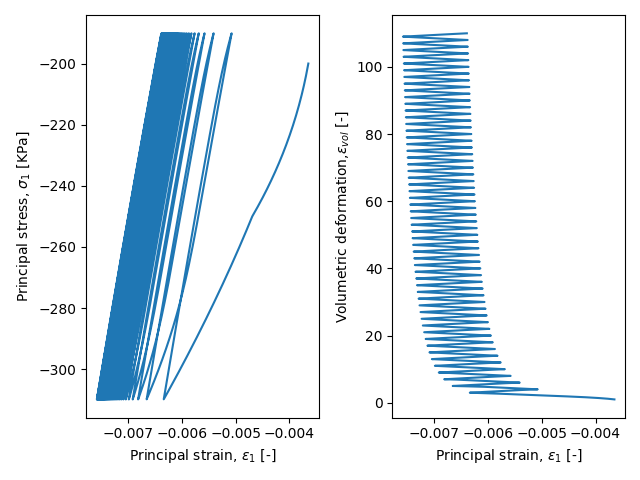
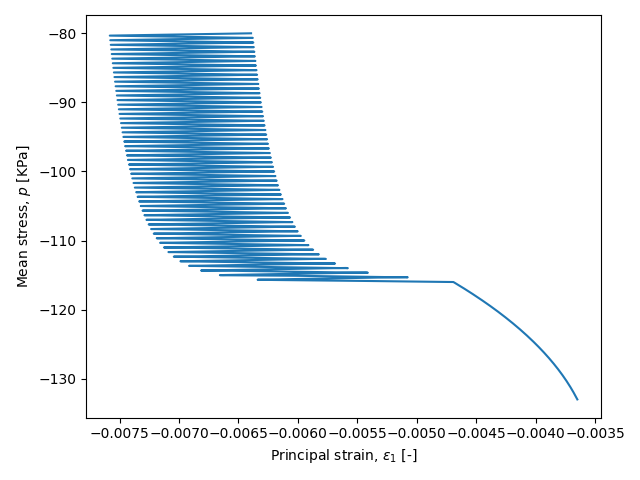
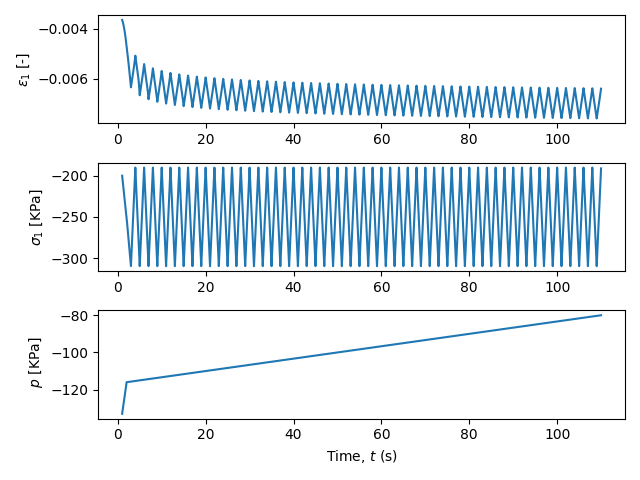
Main references
Liu, H. Y., Abell, J. A., Diambra, A., & Pisanò, F. (2019). Modelling the cyclic ratcheting of sands through. Géotechnique, 69(9), 783-800.
Liu, H.Y. (2020). Constitutive modelling of cyclic sand behaviour for offshore foundations (Doctoral dissertation, Delft University of Technology).
List of works using SANISAND-MS